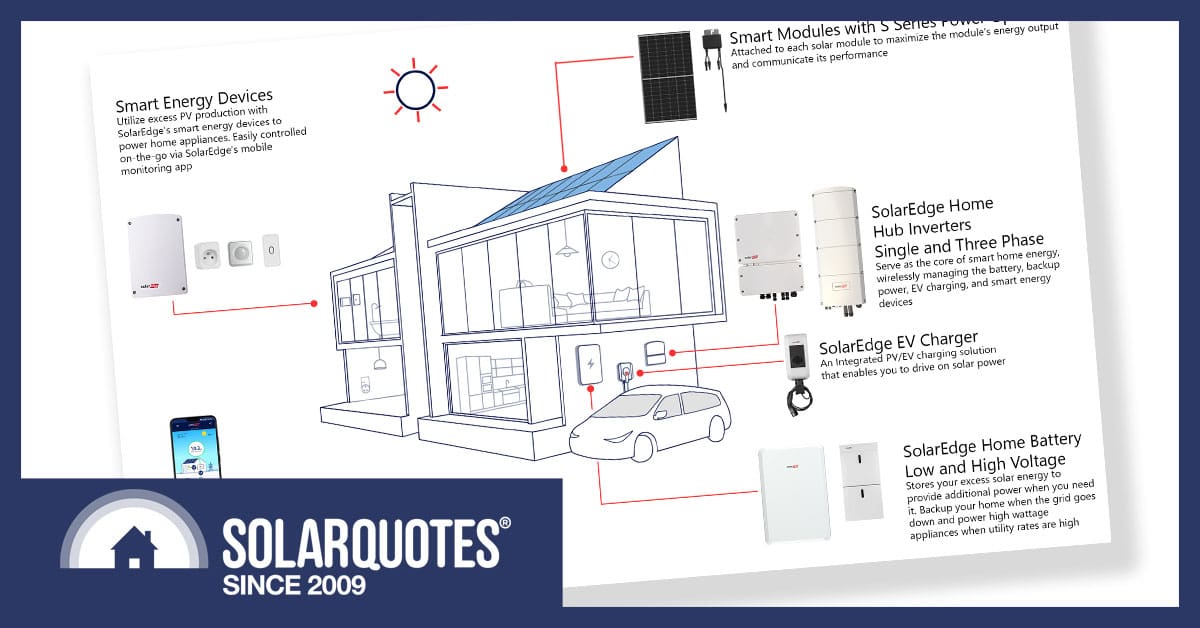
SolarEdge have one of the most complete solar ecosystems available in Australia.
As more homes become all-electric, you must consider how your solar, battery, and EV charger will work together.
This is especially true for EV chargers, one of the most power-hungry appliances.
Why Does Everything Need To Work Together?
Because smart use of your appliances means maximum savings.
For example, if Finn sets his Tesla Model 3 to charge for six hours at a special EV off-peak rate of 8c/kWh, it will cost him $5.
If he charged it as soon as he arrived home and plugged it in, evening peak rates of 50c/kWh would mean six hours of charging would cost him $33.
As electricity prices become more dynamic, there will be more opportunities to charge your home battery and EV from cheap grid electricity—or at least to avoid expensive peak pricing.
Take Finn’s house: a mishmash of Enphase and Solarbridge microinverters, a Tesla Powerwall 2 battery and a Delta AC Max EV charger all work together – but they’d be easier to manage, monitor and control if they were all from the same brand.
Why Go With An Ecosystem?
There are four core benefits to buying your solar, battery and EV charger from one brand:
1) Co-operation
You don’t want your small (by EV standards) home battery flattened by your EV.
Take Tesla: The Powerwall 2 battery holds 13.5kWh, and the standard-range Model 3 car has a 57.5kWh battery.
Discharging the entire battery into the car would only fill it up by 24%. On the other hand, 13.5 kWh could easily cover 100% of the typical Aussie home’s overnight energy use.
Thankfully, if you don’t have an ecosystem able to avoid this at the software level, there’s a relatively simple wiring change your installer can do so your home battery’s energy can never go into your car’s battery. But a software solution is easier and more flexible.
2) Simple Visibility
You don’t want to fumble with four separate apps to understand what’s happening in your home. It’s cleaner to have it all in one and easier to manage.
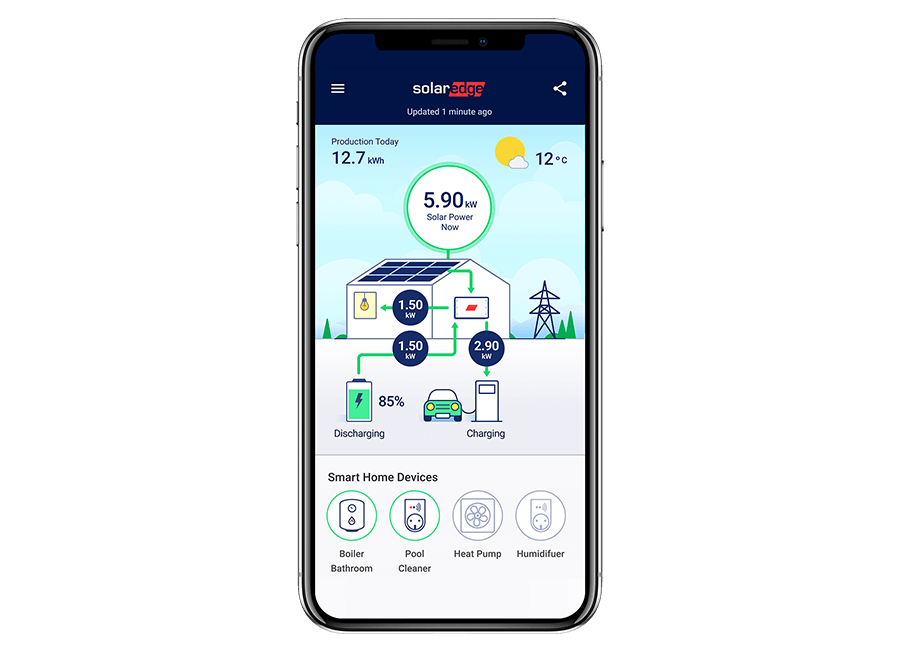
SolarEdge’s “mySolarEdge” app displays solar, battery, and EV charger performance under one roof. Note how the battery goes into the house load instead of the EV!
3) Make life easier for your installer
If your devices are part of one ecosystem, they can share one CT in your meterbox. The more outside brands you add to the mix, the more CTs you need to pack in. If you have a 3-phase home and a different brand of monitoring, EV charging and home battery, you may need to squeeze 9 CTs into your switchboard.

A Current Transformer (CT).
If another electrician needs to work on your switchboard – staying in an ecosystem means there are fewer CTs they can accidentally mess with and send your monitoring and control haywire.
4) All warranties under one roof
Getting warranty support can be a baffling ordeal if you have a salad of different brands installed in your home and something breaks.
It’s your installer’s job to resolve any product faults under warranty. But if the inverter manufacturer blames the EV charger manufacturer, the time it takes to fix the issue will blow out.
When everything’s in one ecosystem, it’s a one-stop shop for warranty, meaning any issues can be fixed immediately.
Ecosystems Might Come With A Price Premium
One argument against buying into an ecosystem comes from the more budget-conscious.
If brand X’s EV charger costs $1800 and brand Y’s has the same feature set for $1000, it can be tempting to choose the cheaper option.
Ask yourself: Is straying from an ecosystem’s warranty protection and ease of use worth the $800 over a system’s lifetime?
Fronius
Battle-tested and ever-popular Fronius has its new series of Gen24 inverters, designed to pair with BYD HVS and HVM batteries.
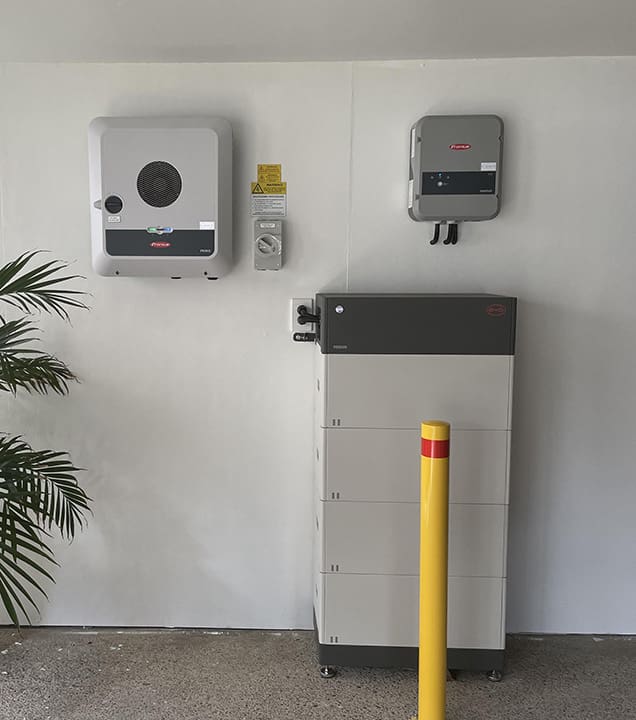
Gen24 and BYD install, done by client DJM Electrical
The Fronius Wattpilot EV charger completes the ecosystem, with the Wattpilot Go offering unique portability.
SolarEdge
Our cover image shows SolarEdge’s “Energy Hub” single-phase hybrid inverters, 10kWh Home Battery, and EV charger.
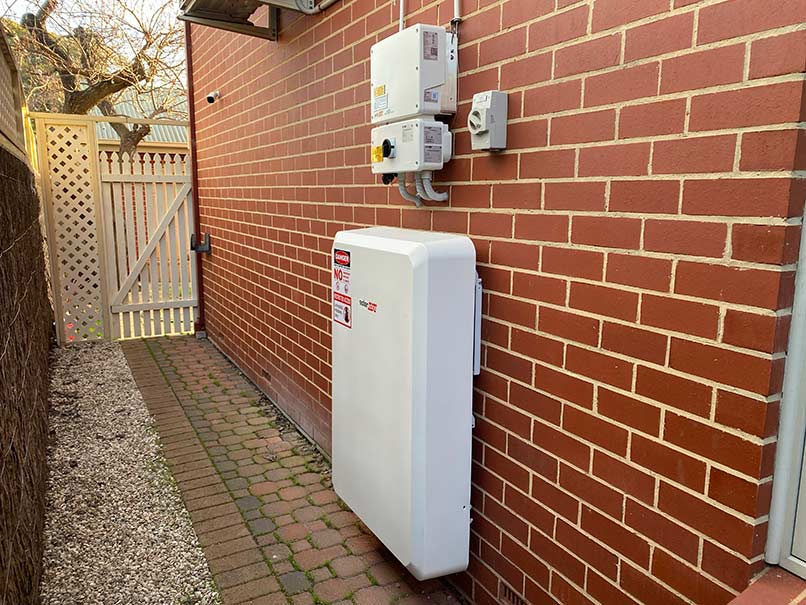
A SolarEdge 10 kWh home battery and Energy Hub inverter.
Besides Fronius & GoodWe, SolarEdge has a complete solution available off the shelf. Priorities are readily customised, so you can choose where your solar is going. However, if you have special storage profiles (e.g., cheap time-of-use retail deals), they can’t be easily controlled via the app. You’ll need to ring your installer to tweak settings if you want to take advantage of “happy hour” charging from the grid. This will hopefully be handed over to the end customer as firmware is developed.
Tesla
Tesla has its Powerwall 2 battery and Tesla Wall Connector EV charger.
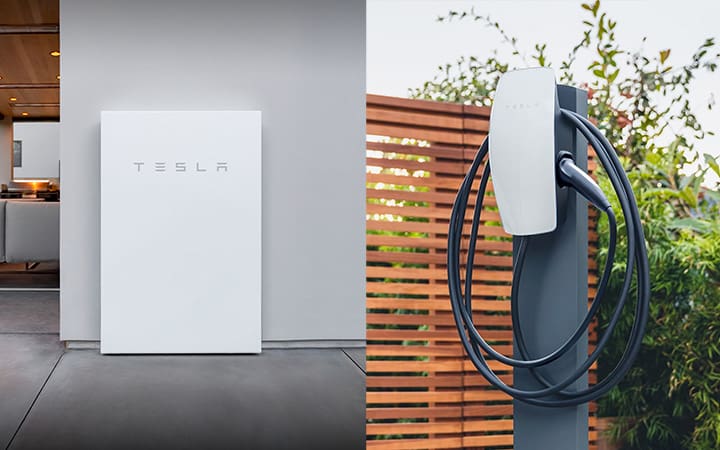
The excellent Powerwall 2, and adequate Wall Connector
By year’s end, it will launch its Powerwall 3 battery, an all-in-one unit containing a solar inverter.
The Tesla wall connector is a dumb device; however, if you have a matching Tesla vehicle, the car controls the smart charging. Charging other EVs with a Tesla charger is often made smart using third-party software such as chargeHQ with its associated monthly subscription.
OCPP-Compatible EV Chargers Are A Must
An OCPP-compatible EV charger means third-party apps like Charge HQ, or signals from your DNSP or electricity retailer can control it, making your EV charging smarter.
OCPP provides additional features your charger may not offer even if you’re in an ecosystem.
For example, if you’re with Amber Electric, Charge HQ can automatically turn your charger on or off based on real-time electricity prices.
Charge HQ also knows your home battery’s status and state of charge (SoC) and can set SoC-based priorities, e.g., “Charge my home battery to 80% first, then charge the EV.”
Dumb Charging Is Already Dead
To help manage grid stability and efficient use of infrastructure, electricity providers are incentivising intelligent use of energy. They offer a carrot in the form of special EV charging tariffs.
Governments are using the stick approach, mandating OCPP-compatible chargers before you can have permission to connect to the grid.
In fact, in Queensland, dynamic control of EV charging is already a must-have if you don’t want to be stuck with slower charging or an off-peak tariff.
In SA, it’s now compulsory for new EV chargers to be compatible with third-party control.
OCPP compatibility will likely soon be de facto mandatory everywhere, so save yourself the trouble and buy an OCPP-enabled charger.
Our EV charger comparison table lists whether or not chargers are OCPP compatible.
Stay In An Ecosystem To Avoid Headaches Down The Road
If you’re buying solar, batteries, and an EV charger in one hit, I advise buying into an ecosystem.
If you have solar and want to add batteries or an EV charger – staying in an ecosystem is harder, but still doable.
The temptation to save money by mixing and matching parts should be far outweighed by the convenience of keeping everything under one roof – especially warranties.
Next, I’ll take a deeper dive into the products available from each brand.

 RSS - Posts
RSS - Posts



Is there a reason you didn’t mention Sungrow’s new line of inverters, batteries and home charger?
yes – they will be covered in PT II
I wish SolarEdge would bring the bidirectional DC coupled evse to Australia but I guess they are waiting on Australian legislation.
I did see that Ambibox just demonstrated bi directional with an Atto 3.
Promising times ahead.
The SolarEdge Bi-Directional charger looks promising. We have been holding off getting a dedicated EV charger until the technology evolves. Just using the mobile UMC charger via a 15A outlet and Charge HQ. Currently have SolarEdge inverter and batteries controlled by the SE app. Including charging via the SE app would be preferred.
I have been following the solaredge bidirectional just because I was DC and grid charging. Still noting on any of their websites and no one replies to my questions from solaredge. I will keep bugging them :D.
Release was meant to be last 1/4 of 2024
But what about Enphase Microinverters and Tesla Powerwall 2 at an Adelaide home??
You just described my house.
Any idea when Sungrow will release their EV charger?
Hi Anthony A word to the wise my 13.7 KWH hour FranklinWH Battery will power my home as you said,but when the sun goes down on these cold winter nights i switch my Reverse cycle Air conditioner on to heat the house and set to a comfortable 24 Degrees my unit Pulls 5KWH out of the battery, which gives me 2 and a bit hours of use. I am on 3 Phase. Regards Hans
24°? That’s Summer temperature!
Are you walking around naked?
I agree that for the average consumer a single source is easier. Also I feel all EV chargers (except Granny chargers) should be OCPP.
I contrl my ZJBeny OCPP charger with an OCPP module in Home Assistant (HA).
HA is great because it can intermix many types of hardware. I have my EV charger, Zenaji 12Kw battery & SolarEdge PV, with Victron to control the battery. I only have singular Current clamps, but my rural setup has the generation 50M from the main loads. HA reads the data from all the inverters, & the house monitoring is performed with an IoTaWatt monitor (also read by HA).
There are already projects being developed for HA that will interface with companies such as Amber.
One comment on Energy retailers, one must very carefully analyse power usage because no company gives anything for nothing: Cheap EV at night can be offset by much higher Peak charges in the late afternoon.
I have been trying to get Red Energy to offer a discount night rate for battery/ev charging. No luck as yet…. In our case, our Kona mostly gets charged from PV, but our Imiev can be charged at any time (due to the limited battery size: usual charge 8 to 10 KW.) We try to time the Imiev charge Off-peak if possible or to use PV.
Hi Anthony, you described an image >>A Current Transformer (CT).
That appears to be the common language for them these days, but aren’t they more correctly called Current Transducers? Current is transduced, ie converted into a voltage, for reading by the monitoring electronics.
Hi Gordon,
The plastic block contains only a coil of many turns. That becomes a transformer with a single turn primary once its core is clipped over a wire.
That much is known as a current transformer. (It is best not operated without a “burden resistor” on the secondary, to avoid potential damage to the coil insulation due to excessive volatage.) Adding a load resistor gives a voltage proportional to primary current. Thus once that is done, the whole may be described as a transducer. (But if a designer chooses to read the current with a Norton amplifier (e.g. an LM3900) instead of a common (voltage amplifying) op-amp, then the current to voltage conversion would not be required, and a transducer would not have been made from the current transformer.
As there will be a small current flowing through the burden resistor, and another small current in the load resistor, my vote is for CT standing for Current Transformer.
“In SA, it’s now compulsory for new EV chargers to be compatible with third-party control.”
Can you provide a link or reference please?
Cheers,
Allan H
https://www.solarquotes.com.au/blog/ev-chargers-sa-mb2930/
On Solaredge – I was able to get them to give me access to the 4 different battery modes which give you full control over your battery in the app so you don’t have to go back to the installer.
You can also schedule car charging through the app where you have the SE car charger.
The other benefit of having the one ecosystem is if you go with Amber’s SmartShift which has taken a lot off the stress out of managing the battery compared to doing it manually on a time of use demand plan. They are also talking about integrating car chargers in the future.
This was a good article but you might have explained up front what OCPP is. I did not know, but my AI overlord tells me it is Open Charge Point Protocol… which is slightly less mystifying. Turns out my EO charger doesn’t have it anyway, but I wont be doing anything about it in the short term.
There is a fine balance between explaining everything and keeping the blog posts concise. There’s a good overview of why OCPP is important here:
https://www.solarquotes.com.au/blog/ev-charger-with-ocpp/
Yes Nigel i am and as Kramer says on an episode on SEINFELD, IM LOVING IT. Regards Hans
My experience with Fronius inverter, Fronius smart meter and Fronius WattPilot has been awful; the integration is poor. For a long while the Fronius Gen24 inverter wouldn’t talk to the Fronius app, SolarWeb, and at the moment I can’t use the Fronius WattPilot on eco mode, because it can’t communicate with the Fronius inverter. The installer has been trying to solve the issues for over a month now, suggesting the problem is inherent.
I just got a 3-phase Zappi installed alongside GoodWe batteries and inverter.
The one installer that got back to me from SolarQuotes suggested going with GoodWe to keep in the same brand ecosystem. But they had no solution to wire the EV charger in a way to avoid using the home battery !
Also, GoodWe monitoring mobile/web apps are really bad IMO (SEMS Portal is a mess) and from my experience in changing the inverter charge behavior of the home battery I decided against GoodWe EV chargers.
So I opted into a Zappi with another installer who was able to write it up to bypass the batteries as well, so I don’t drain it overnight when I have to charge via the grid.
Disagree with this article unless you are a complete novice, in the “I just want that solar battery thing, please and then you pay attention once a quarter to your bills” camp. If you mix and match you can often do well. I have a crap roof with more angles than post-Roman Britain and microinverters from Enphase were the only sane way to go (plus I hate HV DC wiring). Enphase batteries are stupidly expensive and you can’t control them if you are on Amber (to make the most of you solar and batteries), so Tesla was the AC coupled battery of choice for me. I’ve helped other people do other combinations and automate them I haven’t had any complaints.
…and about 1% of the people who install solar on their roofs could do this successfully. This article is not targeted at that 1%.
I suggest the author of the article look at the (Fronius) Wattpilot Users (Australia and New Zealand) Facebook page to see all the problems users are having with integration of Fronius products.
Coming back to this one, this is the main reason I juggle the idea of a Tesla EV versus say a BYD. We have a Powerwall, and I’m sure the integrated experience of a Tesla EV with the Powerwall through the Tesla app would be fantastic. I have seen you post about Tesla EV warranties here before, what’s the current view as to the impact of those on longer term Tesla EV owners? Battery and drivetrain warranty are fine, the guts of the vehicle. But is the 80,000km warranty on the rest causing any significant problems in 2024, that SQ knows of?